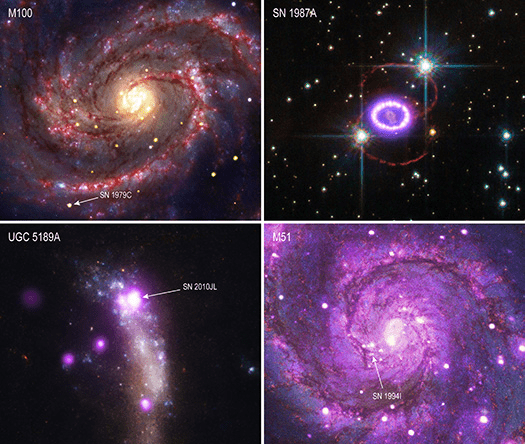Months or years after the immediate burst of radiation put out by supernovas has passed, nearby planets face a further threat. X-rays produced by core-collapse supernovas can damage planets up to 160 light-years away, according to new evidence collected by NASA’s Chandra Observatory. Although there are no supernova candidates anything like this close to Earth today, the discovery may be relevant for past extinction events and offer clues to the Fermi Paradox.
Releasing immense amounts of energy is central to being a supernova. Any planet orbiting one would be sterilized, if it survived at all. Even in nearby star systems habitable planets could become considerably less habitable, although there is debate about how far away one needs to be to be safe.
That initial outburst fades in weeks, but it seems hunkering down through the blast might not be enough. A new paper reveals a problem no one has previously studied. Before Type II supernovas explode, the progenitor star throws off a lot of gas and dust. When the blast wave hits this material X-rays bathe everything around. Based on observations of 31 supernovas by Chandra and other X-ray telescopes, this radiation could be deadly out to a much greater distance than the blast itself, and last considerably longer.
These X-rays probably wouldn’t reach the lower stratosphere, let alone the surface, of a planet with an oxygen-rich atmosphere, but would produce chemicals that greatly damage the ozone layer. This in turn would let in ultraviolet light from the planet’s star. Earth-like life would be unlikely to survive, other than in the deep ocean or underground.
X-ray production varies by supernova. One example considered in the study, SN 2010jl, produced enough X-rays to sterilize an Earth-like planet out to 100-160 light-years away. For others, including 1987a, the X-rays’ lethal range would be much smaller than from the initial blast.

Four of the 31 supernovae. Their initial brightnesses were similar, allowing for distance, but you’d need to go almost 400 times further from SN 2010JL (bottom left) than SN 1987A (top right). Image Credits: NASA/CXC/Univ. of Illinois/I. Brunton et al.
“The Earth is not in any danger from an event like this now, because there are no potential supernovae within the X-ray danger zone,” said Connor O’Mahoney of the University of Illinois in a statement.
Betelgeuse, after all, is 530 light-years away. However, the absence of nearby threats reflects the Sun’s location in a fairly sparsely populated part of the galaxy between two spiral arms. It’s been known for 70 years that being located closer to the galactic core comes with added dangers, but we might have been underestimating just how hard it is to survive in such locations.
The Earth has been close to supernovas in the past – indeed there is evidence both Type Ia and core-collapse explosions preceded the birth of the Solar System. The “Local Bubble” of gas 1,000 light-years or so wide is also thought to be the product of multiple supernova explosions in our vicinity.
No one knows how close our ancestors were to these supernovas, with estimates ranging from the dangerous 60 light-years out to 500 light-years, where the only effect would be a dramatic light show. These, however, have been relatively recent events, the product of passing close to a star-forming region a few million years ago. Evidence of more ancient close passages, which may have reset the clock of life somewhat, may have been erased. We don’t know if we have ever been perilously close to an explosion.
Even after the X-ray threat has passed, nearby planets are not entirely safe. Highly charged particles represent a third, previously studied, danger. Because these are traveling slower than the speed of light they will reach the planet hundreds or thousands of years after the X-rays have faded. However, in some cases, the X-rays probably prove lethal at distances where both the initial light and the subsequently charged particles were mere annoyances.
The study is open access in The Astrophysical Journal
Source Link: Nearby Supernovas Pose An Extra Previously Unconsidered Threat To Life